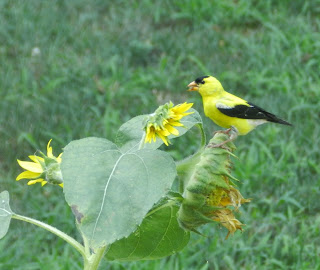 |
| Hemerocallis "Swedish Girl" |
I gave this talk to the Bishop Hill, Illinois, VASA Lodge members several years ago and thought there might be some interest to a wider audience. For those that want to infuse a little of their Scandinavian heritage into their gardens, this might be a beginner's guide.
There is no official national flower in Sweden but each province has an official flower. The Linnea Borealis (or Twinflower) is often considered their national flower because of popularity and abundance.
57% of Sweden is covered in lush forests of elm, oak and maple. Half of their forests are coniferous. Mountain elevations have aspen, mountain ash and birch trees.
Sweden's Carl Linnaeus is one of the world's most noted scientists for developing the system of plant taxonomy. It's still utilized today. The Linnaeus Garden is the oldest botanical garden and is owned by Uppsala University.
Berries are abundant in Swedish forests: Cloudberries and lingonberries (which are only found in Scandinavia,) blueberries and raspberries.
Kitchen gardens were and are a part of the Swedish culture. Botanic gardens vary from royal to plain and functional to naturalistic.
The Swedish Society of Public Parks and Gardens is a good reference for garden planning.
What are the goals of your Swedish themed garden? The following are all different in the outcome but may have overlapping plant choices.
- Period to early Bishop Hill?
- Period to early Sweden?
- Swedish throughout history?
- Modern Swedish?
- Swedish by association?
- Swedish by societal class?
 |
| Hemerocallis "Swedish Nightingale" |
Realize Swedish gardens are diverse because of age, use in Royal gardens, economic class, religious affiliation, how near it is to the sea and mountains. To copy some would be like a Swede seeing a picture of Biltmore Estates and thinking that was how all American gardens looked.
Native plants to Sweden:
Anemone Nemorosa. Locally known as Vitsippa or mosippa. It's a bright white flower with a yellow center that blooms in the spring. It will spread rapidly. The flower petals are open during the day but close or drop at night or during rainfall. It grows close to the ground.
Ranunculus Acis: Locally known as Upright Meadow Crowfoot, meadow buttercup or tall buttercup. It has bright yellow flowers with a long bloom season. Touching can irritate the skin although it's not poisonous. Sometimes it's considered a weed in North America. It's resistant to herbicides so consider the ramifications carefully before introducing into your gardens.
 |
| Blueweed |
Picea Abies: Known as Norway spruce. There are examples still living in Sweden that are 9,500 years old. Can push new trunks out of the soil should the main one be damaged or killed.
Linnea Borealis: Also known as Twinflower. It's a very delicate wild plant about one-inch high and grows in the deep shadows of the Northern spruce forests. The flowers are pin, bell-like and very fragrant. (check out the Twinflower Bed and Breakfast located in Bishop Hill's old hospital.)
European Globe Flower: This yellow orb-shaped flower is also known as smorboll. It's a member of the buttercup family.
Blueweed: It's also known as Viper's bugloss and Echium vulgare. It's located in meadows, has light purple/blue flowers with bright pink interiors and blooms in the summer. It has a 30-inch stalk.
Lily of the Valley: Known as Convallaria majalis. It spreads easily, stays 6-inches in height and has very fragrant white bells on a tiny stem. Blooming in spring, it's a favorite of florists and brides. Grows in sun or shade, moist or dry soil and may be considered invasive.
 |
| Arctic Starflower |
Arctic Starflower: This shade loving flower is also known as chickweed wintergreen. The leaves have a purple tinge and the flowers are tiny and white with a yellow center.
Viola Tricolor: Many call them Johnny jumpups. Small violets in shades of purples and yellow. May self seed.
Flax: This is sometimes grown as a field/commercial crop. It has pale purple flowers with bright yellow centers.
If you're simply wanting to use plants with Swedish names, consider:
Hemerocallis "Swedish Girl". This daylily has 5 1/2 inch soft pastel yellow blooms with distinct lavender edges. Semi evergreen, blooms early to mid season and has 26 inch scapes. Hybridized by Sims in 1987. Was awarded the daylily "Honorable Mention".
David Austin's "Queen of Sweden". A hardy, short upright rose bush. It has a Musk Rose fragrance.
 |
| David Austin Rose "Queen of Sweden" |
There's a whole larger selection of plants that could be added to Swedish gardens. Doing a bed entirely in the colors of the Swedish flag is a good example.
While you're contemplating a Swedish garden, plan a trip to historic Bishop Hill, Illinois. History, beauty, shopping, dining and entertainment. Visit the many websites and Facebook pages for up-to-the-minute happenings.
 |
| Twinflower B&B, Bishop Hill IL |






































